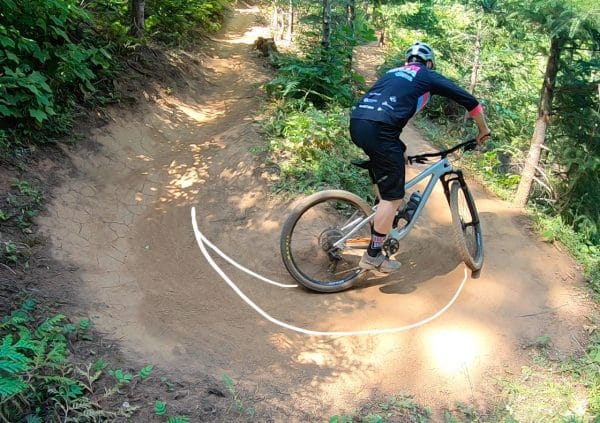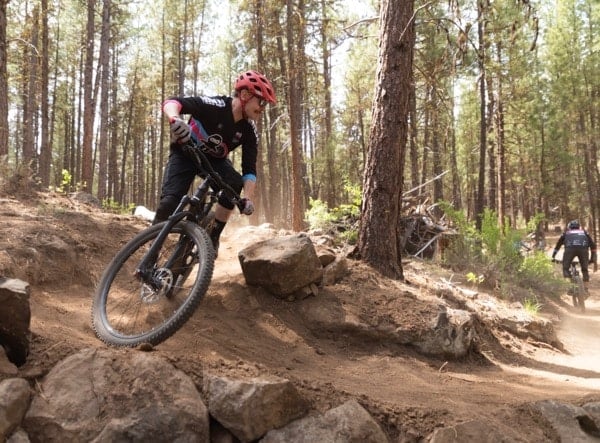Pre-Turn: A Must Know Skill For Smooth, Fast Corners
Picture this: it’s the exact moment that you settle into the flow of a descent when the singletrack throws a hard left or right at you. You lay on the brakes, eek your way around the turn, pedal like mad to get back up to speed and do your best to find your rhythm again… sound familiar?
You’re not alone. It’s one of the most common questions we get asked:
How the heck do I keep my flow and momentum through corners and switchbacks?!
– Every rider ever
Meet the Pre-Turn – a game-changing technique that’s the key to smooth, fast corners. Are you ready?!
Let’s say you’re approaching a left-hand corner or switchback. What are your line options?
1. Inside line
If you approach the corner from inside line (left side of the trail), it will be considerably tighter and sharper and you’ll be unable to carry momentum through it. Plus, your rear wheel always tracks even further inside than your front wheel where it can slip (as shown in the video) or get hung up on an obstacle like a rock or root.

2. Outside line
If you approach the same corner from the outside line (right side of the trail), it will increase the corner’s radius making the corner wider and therefore faster. But beware! There are often sketchier conditions on the outside line such as loose dirt with less traction or broken off trail edges. Additionally, it doesn’t leave you room to go wider if you mis-calculate your speed or the corner’s radius (as shown in the video) – there’s no buffer zone.
3. Pre-Turn
If you’re wondering “what the heck is a pre-turn?” you’re not alone. It’s a turn in the opposite direction of the corner that moves the apex earlier in corner.
Try this:
- Approach on the inside line of the corner
- Prior to the apex, turn right (opposite the direction you intend to turn)
- Transition smoothly into a left turn

Putting these two turns together, the first being a “pre-turn” and the second being the direction of the corner, makes for a very smooth, controlled corner.

Keys to success
Bike-body separation – Separate yourself from the bike by swinging your hips to the outside of the corner and keeping your knees wide to allow the bike to lean beneath you. This separation will naturally allow your outside foot to come to the down position which leads us to…
Footwork – Your outside foot should be down opposite the direction you’re leaning the bike. So, in this case of a left corner, your left foot should be down for the pre-turn, then as you transition to the actual turn, your right foot should be down. Focus on the smooth application of this footwork

It’s a Mystery
While we have no simple explanation of why, two turns back-to-back is wayyyyy smoother than any one turn. And for some unknown reason, when you add a pre-turn you’ll shift your focus from dragging your brake into the corner into good footwork and compression… and that means SMOOTH and FAST!






Cool tip I’m trying this today
That’s great news! Let us know how it goes.
Very well explained. My cornering has been crap lately, this sounds, um, unintuitively right. Thank you.
You’re welcome, Bond. Add the pre-turn to your tool box and let us know how your cornering improves!
Sorry….. but gotta call you out. Here goes:
No explanation of why it works? Well, the first turn is unnecessary; just set-up wide and make the smoothest possible arc through the corner. That’s what’s working—the wider arc. Also, you shouldn’t drop both feet—you really shouldn’t turn twice. No real rider drops a left foot, turns right, then drops a right foot around the left corner (if the foot needs to drop around the left—the real corner—for the correct reasons, that’s ok).
Can you show me someone doing this in high level DH or Enduro racing? Answer: no. Also, teaching beginners, intermediated, etc., this will create bad habits and is dangerous (pedal strikes and just bad technique).
Also, you won’t be able to brake well at all if you’re putting a turn before your turn—especially if you’re dropping a foot. And, this “technique” will be nearly impossible to do with any speed on any steep or difficult trail.
I’m not trying to be a jerk, but this isn’t a technique that is used by decent riders (set up wide? Sure. But the “two turn” thing? You won’t see it)
This bums me out because teaching this kind of BS is bad for the business of mtb coaching. There are all kinds of real and relevant cornering techniques you could teach. Please stick to those. This “two turn” deal is the kind of thing that turns people away from mtb coaching. And that upsets me and takes away from my business.
If you’re coaching good stuff that ALL riders can benefit from, cool. There’s plenty to go around. But this sort of 2-turn thing is pretty kooky, people will get that and now, collectively, mtb coaching takes a hit.
Sorry. But I have a tough time letting stuff like this slide…
Hey Andy — thanks for taking the time to comment!
Happy to share some more examples of your points / comment / questions:
Check this video from Simon Lawton (x-pro DH rider, Ninja contributor and friend), he breaks this down a bit further and provides a solid demo: https://www.youtube.com/watch?v=4t5-IYpVIe4
Also, another great explanation of foot work with detail and demos here: https://www.youtube.com/watch?v=hYBGoDo8VLE
And YES — every single DH rider on a pro level does this.
Are you ever in Oregon? If so, stop by — I’d be happy to meet up for coffee and review some slow-mo with you of the worlds top riders.
Richard / NINJA
P.S. You run a MTB coaching business, right?
Andy,
“…just set-up wide and make the smoothest possible arc through the corner.”
Yes – the pre-turn is a way to “just set-up wide”, which then allows you more space to make the “smoothest possible arc through the corner” and allows you the ability to make adjustments as needed due to terrain.
This video is very basic and the movements exaggerated. As an experienced coach I am sure that you are well aware that you need to exaggerate your demos so your students do at least half of what you are teaching/showing them. Also, the pre-turn can later lead to more aggressive forms of opening up turns and controlling the arc/radius, which is something seen in many pro races – both DH and Enduro, heck even in cyclocross we use this move sometimes. I am not saying that this is for every turn, but it is a great piece of knowledge and a skill to have in your toolbox.
It is even helpful on up hill switchbacks when you need to avoid obstacles. It is useful anytime that you need to control arcs that your wheels track around corners.
What is a Pre-turn? | Mountain bike skills with Simon Lawton from Fluidride https://youtu.be/4t5-IYpVIe4
How To Ride Tight & Steep Switchback Corners On Your Mountain Bike https://youtu.be/3Q_yJHwLJ_A?t=258
Sam Hill Takes On The Hot Lap Challenge | Pinkbike Hot Laps https://youtu.be/VcsHib1ovs4?t=275
How To Ride Blind Corners | Mountain Bike Skills https://youtu.be/9O-hgnV9zVY?t=120
How To Ride Tight Corners – Trail Tips with Nathan McComb – Ep2 https://youtu.be/FbJpsoeC_T0?t=122
How To Ride The High Line | MTB Skills https://youtu.be/3Bst1uxSS80?t=211
EWS 7: A French Classic. Valberg-Guillaume’s Highlights, France https://youtu.be/1IiLhIekHZE?t=1066 (Nicolas Vouilloz – 10 time Downhill Mountain Bike World Champ)
https://youtu.be/1IiLhIekHZE?t=1079
https://youtu.be/1IiLhIekHZE?t=1348
ENDURO WORLD SERIES VITAL RAW – Getting Buck Wild in France! https://youtu.be/L1TI0Uw9-48?t=300 (Ritchie Rude pre-turn to open up the corner)
How to improve your line choice https://youtu.be/JPcmATYqop0
This looks a lot like a technique called counter steering that is used for high speed turns on everything from motorcycles to fire trucks. The dynamics of shifting the mass in one direction before turning sharper in the opposite direction may seem counterintuitive but trust me they do work (:
Physics….it’s all in the physics – we need a science guru to weigh in and explain how this technique affects the interim of bike and rider. Any science stud(ess)es out there?
One explanation that I have seen (which is probably in one of the many linked videos in the earlier comments) is that the pre-turn sets the rear wheel on a better line so that it hits the apex of the turn closer to the same line as the front wheel rather than tracking farther in. If you’ve ever seen an 18-wheeler (or anything pulling a trailer) make a right turn, that’s exactly the same technique they use to get the trailer on a wider track so it doesn’t clip the inside of the turn.
Counter-steering, as applied to M/C’s, works at speeds over 10mph, (poss. a little less). Bicycles are similar.
By turning the front wheel a little away from the corner, ( i.e. right when intending to turn left) you change the geometry of the bike. Apparently, we do this subconsciously on bicyles & combine it with body lean.
The change of geometry has the effect of tilting the bike into the intended corner direction. At higher speeds, particularly m/c racing, it helps when you have to turn the bike very fast & as a rule, they are a big heavy lump to turn, compared to a bicycle.
I think if you just turn the wheel say left for a left corner, it’s ok at very slow speeds but doesn’t work when going faster. You actually need the (counter intuitive) change of geometry to make the corner. There are numbers of YouTube vids about it.
Obv. with bicycles, you have pedal position to consider & have to prepare accordingly. We all know what a pedal strike can do!